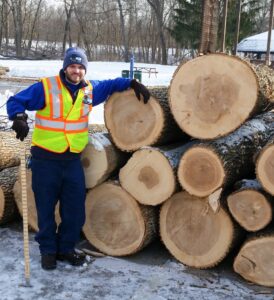
Wood stores carbon throughout its life. Photo credit: DNR
Wisconsin’s forests and forest products have a dual role in climate change. They are impacted by climate change, but also help mitigate its effects by storing carbon in wood products from sustainably harvested forests.
Sustainably managed forests in Wisconsin provide essential raw materials for more than 1,200 wood product companies and 280 logging businesses. Annual forest growth in the state significantly exceeds the volume harvested. In 2013, Wisconsin’s primary wood-using mills received 307 million cubic feet of industrial roundwood, while net growth reached 576 million cubic feet — an impressive 18 cubic feet of wood growing every second – and enough to fill Camp Randall Stadium roughly 108 times over.
When sustainably harvested wood is used in long-lived products such as lumber, furniture, windows and doors, it stores carbon throughout its life, only releasing it back into the atmosphere when it decays. Compared to concrete and steel, wood is gaining popularity as a building material due to its carbon-storing capacity – about half of dry wood is carbon – and its renewability. Additionally, it requires a less energy-intensive manufacturing process.
However, Wisconsin’s forest products industry is also feeling the effects of climate change. Warmer winters lead to more frequent thaws, preventing the machinery needed to manage forests and transport harvested wood from accessing the land.
Doubly, Wisconsin’s diverse soils and forest types mean some species are more vulnerable to climate change, whereas others may adapt. For instance, drier conditions and higher temperatures will increase wildfire risks and reduce habitat for northern species. At the same time, central Wisconsin hardwoods, such as hickory, black oak and walnut, may thrive and expand their range.
Recognizing forests as one of the most effective nature-based solutions to climate change, Wisconsin joined the U.S. chapter of the global Trillion Trees Initiative, led by the World Economic Forum and American Forests. This effort supports wildlife habitats, rural economies and equitable urban tree canopies, while promoting responsible forest management across the state. On Earth Day 2021, Gov. Tony Evers took action to protect Wisconsin’s forestland, signing an executive order to conserve 125,000 acres and plant 75 million trees by 2030. By Earth Day 2024, with more than 32 million trees planted, Evers raised the state’s Trillion Trees Pledge to 100 million trees by 2030. The updated goals include planting 99 million trees in rural areas and another one million in urban areas.
In tandem with the Trillion Trees Pledge, Wisconsin also addresses broader climate challenges through the Wisconsin Initiative on Climate Change Impacts (WICCI), a partnership between the University of Wisconsin-Madison’s Nelson Institute for Environmental Studies, the Department of Natural Resources, and other organizations. This collaboration of scientists and stakeholders is dedicated to evaluating the effects of climate change on Wisconsin and fostering solutions. WICCI’s working groups conduct science-based assessments of climate change impacts on specific regions, ecosystems, communities and industries and works to develop adaptation strategies focused on air, land, water and people.
Learn more about Wisconsin’s Trillion Trees Pledge and the WICCI online.
